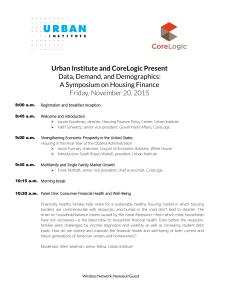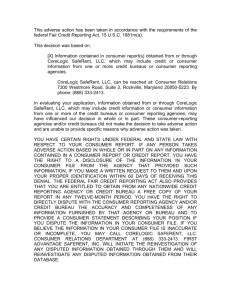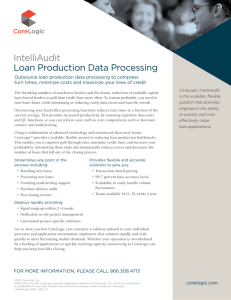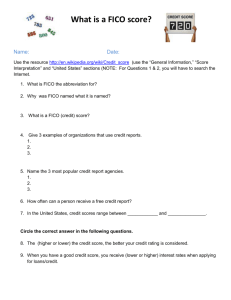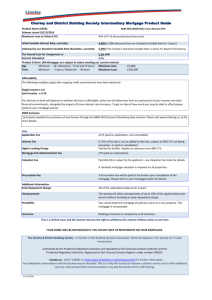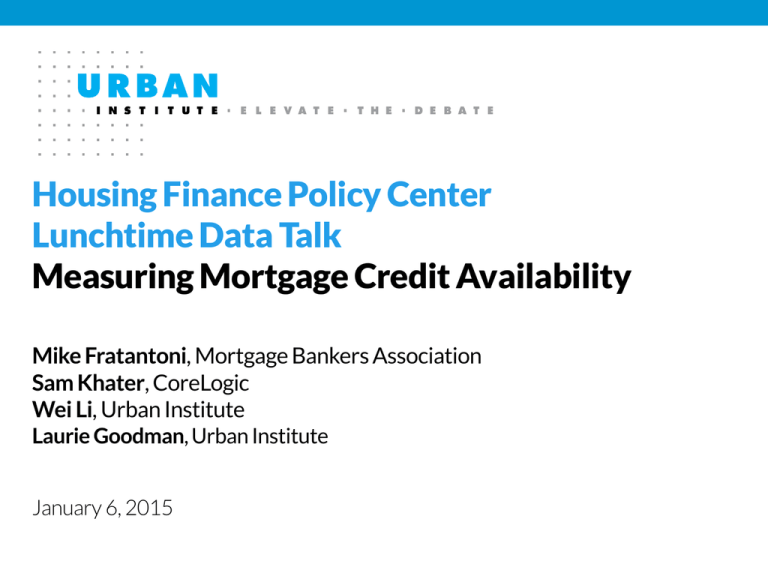
Housing Finance Policy Center
Lunchtime Data Talk
Measuring Mortgage Credit Availability
Mike Fratantoni, Mortgage Bankers Association
Sam Khater, CoreLogic
Wei Li, Urban Institute
Laurie Goodman, Urban Institute
January 6, 2015
Federal Reserve Senior Loan Officer Opinion Survey
Net percentage tightening lending standards
120
Subprime
100
All loans
Non-traditional
Prime
80
60
40
20
0
-20
1998 1999 2000 2001 2002 2003 2004 2005 2006 2007 2008 2009 2010 2011 2012 2013
Source: Federal Reserve.
2
Traditional Denial Rate
Percent of purchase applications denied
30
25
20
15
10
1998 1999 2000 2001 2002 2003 2004 2005 2006 2007 2008 2009 2010 2011 2012 2013
Source: Home Mortgage Disclosure Act data and Urban Institute calculations.
3
Median Borrower FICO Score at Origination
PLS and Portfolio
GSE
FICO score
FHA/VA
800
775
750
725
700
675
650
625
1998 1999 2000 2001 2002 2003 2004 2005 2006 2007 2008 2009 2010 2011 2012 2013
Sources: CoreLogic Servicing data and Urban Institute calculations.
4
Mortgage Credit Availability Index
January 6, 2015
Presented by
Mike Fratantoni
Chief Economist
Mortgage Bankers Association
Presented by
David H. Stevens
President, Mortgage Bankers Association
Background on MCAI
The Partnership
AllRegs ®
Market
Clarity ®
Data
MBA
Proprietary
Model
Mortgage
Credit
Availability
Index
7
Objectives for the MCAI
• Measure the quantity and quality of mortgage credit supplied to the market
over time and for different segments of the market
• Specifically identify drivers of changing availability over time
• Provide an industry benchmark for lenders to assess their own credit
standards
• Provide a time series for policymakers and modelers to utilize in assessing
the state of the market
• Add a dimension to mortgage market analysis – data should be orthogonal to
existing data on transaction volume and composition
8
The Data
• Information on >3,000 unique loan programs each month
• Across 85-100 investors
• Includes Fannie, Freddie, FHA, MI Co’s, and other large, medium, small investors.
• Broker and Correspondent
• Attribute examples:
• Minimum FICO
• Max LTV
• Loan “type” (FHA/VA/Rural/Conventional)
• Doc. Requirements (of income; of assets; of employment)
• Allowable occupancy status
• Fixed vs. ARM vs. Balloon
• Much more (80+ additional data fields!)
9
The Analysis – Data Transformation
• Transformation of AllRegs Market Clarity Data by MBA analyst.
• TERM:
Original = “5,10,15,30”
Transformation: Min Term=5; Max Term=30
• PURPOSE:
Original = “Cash Out Refinance, Purchase, Rate and Term Refinance”
Transformation: “Allows Cash Out”
• Granular data is categorized for standardization and analysis.
• MAX LTV
Original = 95.6 OR 95 OR 92 OR 98.5, etc…..
Transformation =
° LTV <=90
° LTV >90 and <=95
° LTV >95
10
Seven Dimensions of Risk Weighting
Amortization
Product_Type Weight
FIXED
ARM
BALLOON
IO/Amortization
Int_Only_Flag
NON-IO
NON-IO
NON-IO
INTEREST ONLY
INTEREST ONLY
INTEREST ONLY
Product_Type Weight
FIXED
ARM
BALLOON
FIXED
ARM
BALLOON
Loan Purpose
purpose_ROLLUP
Allows Rate/Term Refi, Not Cash Out
Allows Cash Out Refi
Purchase Transactions Only
Weight
Loan Term
term_ROLLUP
Max Term <= 30
Max Term >30
Doc.Type
Doc_Type_ROLLUP
Weight
Weight
FULL/ALT DOC
STATED DOCUMENTATION (Anywhere the word *Stated* appears)
NO DOC (Anywhere the word *NO* is mentioned, excludes any entries with the word *STATED*)
LTV / Occupancy Joint
Max_LTV_Bracket
LTV <=90
LTV >90 and <=95
LTV >95
LTV <=90
LTV >90 and <=95
LTV >95
LTV <=90
LTV >90 and <=95
LTV >95
occupancy_ROLLUP
Allows Investor Homes
Allows Investor Homes
Allows Investor Homes
Allows Second Homes, Not Investor
Allows Second Homes, Not Investor
Allows Second Homes, Not Investor
Owner Occupied Only
Owner Occupied Only
Owner Occupied Only
FICO / LTV Combo
Weight
Max_LTV_Bracket
LTV >95
LTV <=90
LTV >90 and <=95
LTV >95
LTV >90 and <=95
LTV <=90
LTV <=90
LTV >95
LTV >90 and <=95
Min_FICO_Bracket
FICO <=620
FICO <=620
FICO <=620
FICO >620 and <=680
FICO >620 and <=680
FICO >620 and <=680
FICO >680
FICO >680
FICO >680
Weight
NOTE: The more red shading, the more influence a specific attribute will have over the way the Master Index moves. All 7 boxes are only shaded relative to the other items within a specific box, meaning shading
is independent for each box. In addition to the 7 dimensions, MBA also examines loan type (FHA, VA, etc.) and loan size type (Conforming, Conforming/Jumbo, Jumbo) for analytical insight but does not weight
based on these features.
11 as
Investors offer many variations of standard products. In particular, there are a wide variety of ARM products that utilize different indexes or vary along other dimensions. The MCAI captures these variances
additional offers of credit. However, it is important to note that most loans getting done today are drawn from a relatively short product list. For example, according to Weekly Application Survey data, as of
April 2013, 87% of purchase loans were 30-year fixed-rate, and only 5% were ARMs of any type.
Methodology and Risk Factors
MCAI / Risk Factor Methodology
° n is the number of unique programs
° i counts the risk factors (1 to 8) and
° j enumerates the possible categories within each risk factor
• Countij = number of unique programs offering a product in a particular category of
a risk factor.
• Weightij = marginal impact of a particular category on the probability of default.
Weights are derived from publicly available estimates of relative default risk
• Ultimately the AvgRiskScore of a given month is converted into an index value
relative to AvgRiskScore of March 2012.
12
Conventional and Government MCAI
MCAI: Total, Conventional, Government
•Conventional and Government MCAI, how are they different:
•Population Examined (Total = All Programs)
•Gov’t = FHA/VA/USDA/Rural Programs
•Conv = Conventional Programs
•Base Periods (Total: March-2012=100)
•Conventional: March-2012=69
•Government: March-2012 = 222
•Why different base periods?
•Most impactful changes occurred prior to 2011
•Calibrated the Conventional and Government indices to better
represent where each index might fall in March 2012 (the “base
period”) relative to the Total=100 benchmark.
Total MCAI
Conventional MCAI
Government MCAI
14
Recent Trends in Credit Availability
Total MCAI
Higher = Credit More Available
Lower = Credit Less Available
16
Source: MBA’s Mortgage Credit Availability Index (MCAI)
…with Historical Reference
1000
900
3/2011 through present (rescaled)
Higher = Credit More Available
Lower = Credit Less Available
800
700
600
500
400
300
200
100
0
17
Source: MBA’s Mortgage Credit Availability Index (MCAI)
Reoccurring Themes
Credit Availability Trends from 2014:
• Jumbo [and more jumbo].
• Cash-out come-back
• QM/ATR and MCAI:
• Significant pull-back on:
• Interest-Only
• 3-year ARMs (due to “must qualify at max rate for 5 years”).
• >30 year allowable terms
° All three: down, not out.
• Programs allowing for financing of building/construction/improvement costs
through first lien (one-time-close, FHA 203(k), etc.)
18
Thinking Ahead … 2015 and Beyond
Monitoring data with regards to:
• Rep + Warrant changes – how will they surface in the data?
• Credit Score Overlays
• Late 2012: 50-60 “credit score points” above min. guideline requirement for
both conventional (min=620) and FHA (min=580)
• Late 2014 (spreads narrow): 40-50 “credit score points” above min. guideline
• Broker vs. Correspondent: Broker higher
•
What to expect with reintroduction of 97LTV with Fannie/Freddie?
• Different timelines
• Fannie: effective 12/15/2014 (now)
° Certain options only available to low/mod borrowers
• Freddie: effective 3/23/2015
° Freddie program not limited to FTHB
• Investor lag / Investor Pickup
19
Questions?
MBA Research Single-Family Data / Surveys
www.mba.org/research
MBAResearch@mba.org
National Delinquency Survey
State Mortgage Activity Report
Mortgage Credit Availability Index (MCAI)
Custom Origination Reports
www.mba.org/nds
www.mba.org/SMAR
www.mba.org/MortgageCredit
www.mba.org/Originations
Weekly Applications Survey
Builder Applications Survey
Executive DataBook
www.mba.org/WeeklyApps
www.mba.org/builder
www.mba.org/Originations
MBA Mortgage Finance and
Economic Forecast
www.mba.org/forecasts
21
Housing Credit Index
Urban Institute, January 6, 2015
©2014 CoreLogic, Inc. All rights reserved. Private & Confidential
Presentation Outline
• Credit Box Overview
• Distributional Shifts in Major Underwriting Components
• Overview of Housing Credit Index
• Recent Mortgage Performance
23
©2014 CoreLogic, Inc. All rights reserved. Private & Confidential
©2014 CoreLogic, Inc. All rights reserved. Private & Confidential
100+ - 105
95+ - 100
90+ - 95
85+ - 90
80+ - 85
75+ - 80
70+ - 75
65+ - 70
60+ - 65
55+ - 60
< 55
<500
520 - 539
560 - 579
600 - 619
640 - 659
680 - 699
720 - 739
760 - 779
800+
2000 Purchase Credit Box
Purchase Credit Box Visualization
6.0%
5.0%
4.0%
3.0%
2.0%
1.0%
0.0%
24
©2014 CoreLogic, Inc. All rights reserved. Private & Confidential
100+ - 105
95+ - 100
90+ - 95
85+ - 90
80+ - 85
75+ - 80
70+ - 75
65+ - 70
60+ - 65
55+ - 60
< 55
<500
520 - 539
560 - 579
600 - 619
640 - 659
680 - 699
720 - 739
760 - 779
800+
2005 Purchase Credit Box
Purchase Credit Box Visualization
6.0%
5.0%
4.0%
3.0%
2.0%
1.0%
0.0%
25
©2014 CoreLogic, Inc. All rights reserved. Private & Confidential
100+ - 105
95+ - 100
90+ - 95
85+ - 90
80+ - 85
75+ - 80
70+ - 75
65+ - 70
60+ - 65
55+ - 60
< 55
<500
520 - 539
560 - 579
600 - 619
640 - 659
680 - 699
720 - 739
760 - 779
800+
2010 Purchase Credit Box
6.0%
5.0%
4.0%
3.0%
2.0%
1.0%
0.0%
26
©2014 CoreLogic, Inc. All rights reserved. Private & Confidential
100+ - 105
95+ - 100
90+ - 95
85+ - 90
80+ - 85
75+ - 80
70+ - 75
65+ - 70
60+ - 65
55+ - 60
800+
760 - 779
720 - 739
680 - 699
640 - 659
600 - 619
560 - 579
520 - 539
<500
2014 Purchase Credit Box
6.0%
5.0%
4.0%
3.0%
2.0%
1.0%
0.0%
27
Purchase Underwriting is Not Loosening
75th Percentile of Debt to Income Ratio for Purchase Loans
Source: CoreLogic, October 2014, 30-year fixed-rate purchase mortgages only
©2014 CoreLogic, Inc. All rights reserved. Private & Confidential
28
Purchase Underwriting is Not Loosening
10th Percentile Credit Score for Purchase Loans
Source: CoreLogic, October 2014, 30-year fixed-rate purchase mortgages only
©2014 CoreLogic, Inc. All rights reserved. Private & Confidential
29
Housing Credit Index
•
Uses principal components to measure variability of mortgage underwriting
characteristics
•
Utilizes CoreLogic prime/subprime loan level servicing data
•
Index is benchmarked to January 2000
•
Inputs Include:
• Origination Credit Score
• Origination Loan-to-Value Ratio (LTV)
• Debt to Income Ratio (DTI)
• Broker Share
• Adjustable Rate Mortgage Share
• Documentation Type
30
©2014 CoreLogic, Inc. All rights reserved. Private & Confidential
Housing Credit Index
Digression
• Only accounts for supply side analysis, not demand
• What’s an acceptable rate of default?
Caveats and Potential Improvements
• Assumes 2000 is ‘normal‘ underwriting benchmark
• Appraisal quality and sustainability of valuation
• Income and occupancy misrepresentation
• Simultaneous 2nds and HELOCS
• Credit can by rationed by price not just quantity
31
©2014 CoreLogic, Inc. All rights reserved. Private & Confidential
Housing Credit Index
32
©2014 CoreLogic, Inc. All rights reserved. Private & Confidential
Housing Credit Index
33
©2014 CoreLogic, Inc. All rights reserved. Private & Confidential
Housing Credit Index
by Loan Purpose
34
©2014 CoreLogic, Inc. All rights reserved. Private & Confidential
Housing Credit Index
35
©2014 CoreLogic, Inc. All rights reserved. Private & Confidential
Housing Credit Index
Purchase Index by Census Region
36
©2014 CoreLogic, Inc. All rights reserved. Private & Confidential
‘Hedonic Mortgage’ Performance
90+ Delinquency Rate
Source: CoreLogic, September 2014
37
©2014 CoreLogic, Inc. All rights reserved. Private & Confidential
Thank You!
www.corelogic.com/blog/
@CoreLogicEcon
38
©2014 CoreLogic, Inc. All rights reserved. Private & Confidential
HCAI:
A New Credit Availability Index
Wei Li
wli@urban.org
Housing Finance Policy Center
January 6 , 2015
Credit Availability Measures the
Tightness of the Credit Box
40
Loan
Applications
Credit Box is
a Black Box
Originated
Loans
41
A direct measure of the credit box is daunting!
Secondary Market
Lenders
Lender’s Approval
Standards
GSEs
Lender A
Borrower
creditworthiness
Government
Channels
Lender B
Product
Choices
PLS and
Portfolio
And many
more lenders
42
An indirect but intuitive measure of the
credit box:
How much default risk the market
takes at any given time?
43
Conceptually, the market increases credit
availability by taking more default risk, and
vice versa.
44
Measuring Credit Availability by the Amount of
Default Risk Taken By the Market
Perfect as an index which naturally weights and
aggregates multiple risk factors (FICO, LTV, DTI,
Product features, etc.) of all the loans originated at
any given time into a single number.
45
Measuring Credit Availability by the Amount of
Default Risk Taken By the Market
The number reads meaningfully:
A lower value:
Market is taking less risk
Credit is less accessible
A higher value:
Market is taking more risk
Credit is more accessible
46
Measuring Credit Availability by the Amount of
Default Risk Taken By the Market
× It’s not the actual default rate experienced by
the market after origination.
It’s the accepted but unrealized risk at
origination.
47
Product
Risk/Mix
Lower
Credit
Score
Risk Accepted
But Unrealized
at Origination
Economic Conditions
after Origination:
Chance of Housing
Bust
Job Loss Rate
Payment
Shocks
Borrower
Risk/Mix
Lower
Down
Payment
Higher
Debt to
Income
Ratio
Actual
Default
Rate After
Origination
48
“Convert” Borrower and Product Mix into Measurable and
Comparable Default Rate
Vintage 1
Vintage 2
Vintage 3
Borrower +
Product
Mix
1
Borrower +
Product
Mix
2
Borrower +
Product
Mix
3
Same Typical Economic
Condition After
Origination
Same Typical Economic
Condition After
Origination
Same Typical Economic
Condition After
Origination
Measurable and
Comparable
Default Rate
1
Measurable and
Comparable
Default Rate
2
Measurable and
Comparable
Default Rate
3
49
Two Typical Economic Conditions
• The normal economic conditions:
Actual economic conditions experienced by
loans originated in 2001 and 2002.
• The stressed economic conditions:
Actual economic conditions experienced by
loans originated in 2005 and 2006.
50
Borrower and Product Mix:
Divide Each vintage of loans into
6×6×5×2 = 360 buckets
6 FICO
Buckets
6 CLTV
Buckets
>740
0-68
701-740
69-78
661-700
79-81
621-660
82-90
581-620
91-95
300-580
>95
5 DTI
Buckets
Full doc &
0<DTI<30
Full doc &
30<=DTI<40
Full doc &
40<=DTI<50
Full doc &
DTI>=50
Low or no
documentation
2 Product
Buckets
Without Risky
Features
With Risky
Features
51
“Convert” the Borrower and Product Mix at Origination
into Measurable and Comparable Default Rate Under the
Normal Economic Conditions
• For each of the 360 buckets of loans originated at
any given time, its default risk under the normal
condition equals the actual default rate of the
same bucket of loans originated in 2001 and 2002.
• The total default risk for the whole vintage of loans
under the normal condition equals the average of
the above 360 default rates weighted by the
volume of loans in each bucket.
52
HFPC’s Credit Availability Index (HCAI)
for a vintage
90% X
The vintage’s total
default risk under the
normal condition
+
10% X
The vintage’s total
default risk under the
stressed condition
53
360 Actual Default Rates of Loans Originated in 2005 and 2006
Backend
DTI
CLTV
(0,68]
Full Doc
&
(0,30)
(68,78]
(78,82)
[82,90]
(90,95]
>95
(0,68]
Full Doc
&
[30,40)
(68,78]
(78,82)
[82,90]
(90,95]
>95
Without Risky Product Features
>740
1
2
3
4
4
7
1
3
5
5
6
9
(700,740] (660,700] (620,660] (580,620]
2
6
7
7
7
12
3
7
9
9
9
15
3
7
8
10
12
19
5
10
13
13
14
22
6
11
13
16
18
29
8
15
17
19
21
33
11
16
17
20
21
40
12
19
21
24
28
43
≤580
19
25
25
32
40
51
18
26
28
33
43
55
54
Source: CoreLogic and SFPD; UI Calculations
Mortgage Credit Availability:
1998Q1-2013Q4
55
The Whole Mortgage Market
Source: UI’s HCAI
56
The Government Channel
Source: UI’s HCAI
57
The GSE Market
Source: UI’s HCAI
58
The PLS and Portfolio Market
Source: UI’s HCAI
59
Credit Availability
Credit availability measures the probability that a
consumer with a need for credit can secure a loan at
a given time.
60
Mortgage Application Deter and Denial Rate for Weaker Consumers
200 Weaker Consumers with Credit Need
Deter Rate
=(200-100)/200
=50%
100 Weaker Applicants
Real Denial Rate
=(100-20)/100
=80%
20 Weaker Borrowers
61
Li, Wei, and Laurie Goodman. "Measuring Mortgage Credit Availability
Using Ex-Ante Probability of Default." Washington, DC: Urban
Institute (2014).
Li, Wei, and Laurie Goodman. "A Better Measure of Mortgage
Application Denial Rates." Washington: Urban Institute (2014).
Li, Wei, Laurie Goodman, Ellen Seidman, Jim Parrott, Jun Zhu, and Bing
Bai. "Measuring Mortgage Credit Accessibility." Washington, DC:
Urban Institute (2014).
http://www.urban.org/center/hfpc/
62
Please visit http://www.urban.org/events/ for all
materials related to today’s data talk.
63


